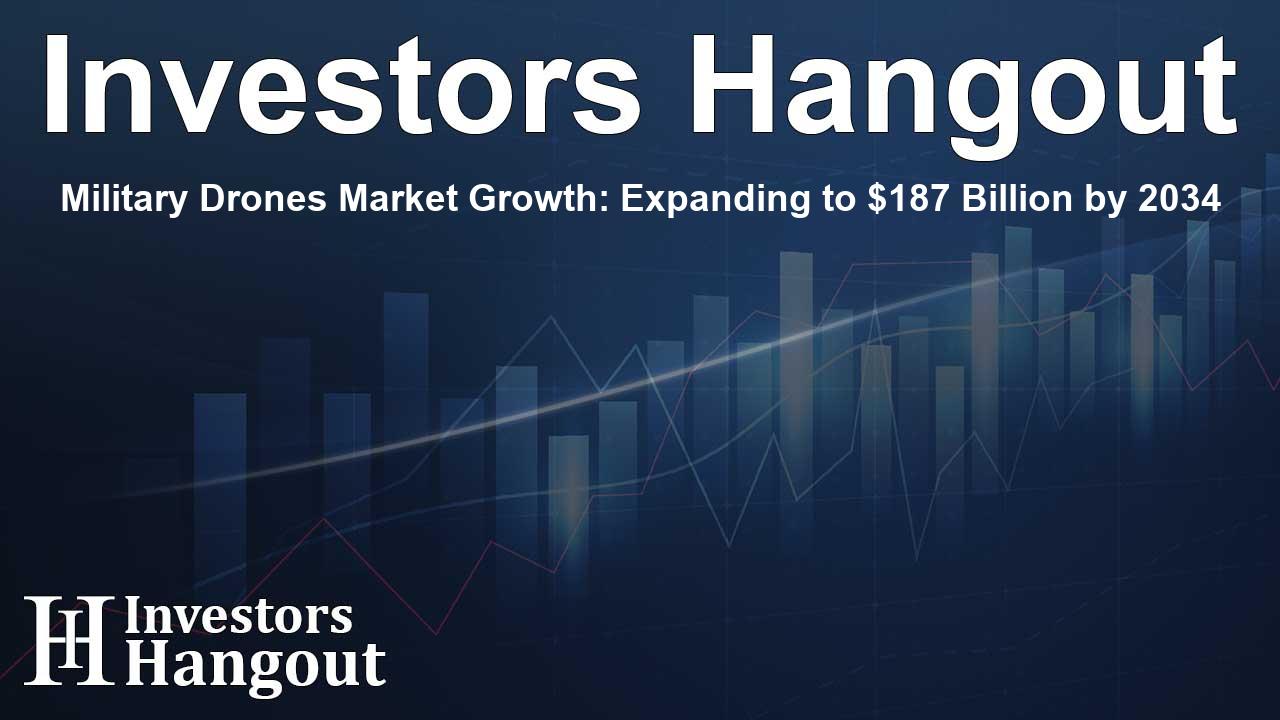Military Drones Market Growth: Expanding to $187 Billion by 2034

Military Drones Market Growth and Projections
The military drones market is on the verge of substantial expansion. It is set to achieve an estimated value of USD 60 billion in the very near term, with projections indicating a growth rate of 12% CAGR, potentially reaching nearly USD 187 billion by 2034. Several factors are propelling this increase, notably the escalation of geopolitical tensions, advancements in drone technology, and ongoing defense modernization efforts across the world.
Market Dynamics Driving Growth
Fixed-wing drones hold a leading position in the market, capturing approximately 45% market share due to their extended range and endurance capabilities. Surveillance applications dominate at 40%, driven by heightened demands for border security and real-time intelligence. Defense organizations constitute the largest consumer segment, accounting for 60% of overall market demand.
Technological advancements, particularly in artificial intelligence (AI), autonomous systems, and payload capabilities, are significantly enhancing military drone functionality. However, the market faces challenges such as regulatory complexities, ethical concerns surrounding drone usage, and high costs associated with procurement.
Geographic Growth Areas and Key Players
Growth is anticipated in regions like Asia-Pacific, with major investments pouring in from prominent players including Northrop Grumman, General Atomics, and Lockheed Martin. This presents vast opportunities for stakeholders aiming to capitalize on innovation and form strategic partnerships within the defense sector.
Key Factors Fueling Market Expansion
Increasing Geopolitical Instabilities: As conflicts and tensions rise, nations are prioritizing defense spending on advanced unmanned aerial systems, seeking to enhance situational awareness and reaction capabilities.
Artificial Intelligence and Automation: The integration of AI into drone systems is revolutionizing operations, improving mission adaptability and precision targeting while reducing the need for human intervention.
Demand for Intelligence, Surveillance, and Reconnaissance (ISR): Modern warfare's shift towards information superiority has triggered a surge in demand for advanced ISR platforms, equipping military strategists with vital battlefield data.
Emerging Economies Modernizing Defense: Many developing nations are upgrading their military technologies, striving to improve their defense capabilities through cutting-edge drone technology.
Public-Private Partnerships in R&D: Collaborative efforts between governments, defense companies, and tech innovators are driving rapid technological advancements and funding for the development of next-generation systems.
Challenges Facing the Military Drones Market
Despite robust growth prospects, the market is hindered by:
Regulatory and Legal Constraints: Varied regulations, export controls, and airspace restrictions can complicate deployment and international collaborations.
Ethical Concerns: The potential use of drones for autonomously making lethal decisions raises significant moral and ethical questions regarding accountability and adherence to humanitarian laws.
High Lifecycle Costs: Designing, producing, and maintaining sophisticated military drones requires considerable investments, which can burden defense budgets, particularly for smaller nations.
Global Geopolitical Risks: Supply chains are vulnerable to geopolitical tensions and trade disputes, which can disrupt access to critical components and hinder production timelines.
Market Segmentation Insights
Product Type:
Fixed-wing drones are favored for long missions, while rotary-wing drones find their place in tactical operations. Hybrid drones are also emerging due to their versatility.
Application Areas:
Surveillance remains the primary demand driver, followed by combat and a growing need for cargo transport capabilities.
Technology:
Remotely piloted systems are currently predominant, but autonomous drones that leverage AI are growing swiftly.
End Users:
The defense sector leads adoption, with government agencies and private contractors increasingly engaged in the military drone space.
Regional Insights:
North America currently leads with 42% market share, but Asia-Pacific is projected to experience the fastest growth at 8.5% CAGR.
Key Industry Players
Leading companies within the military drone sector include Northrop Grumman Corporation, General Atomics, Boeing Company, Lockheed Martin Corporation, and Raytheon Technologies, among several others.
Recent Developments in the Industry
In recent months, significant advancements have emerged within the military drone sector. For instance, Northrop Grumman's MQ-4C Triton successfully achieved Initial Operating Capability with the U.S. Navy, marking a critical milestone for maritime surveillance capabilities. Similarly, General Atomics has entered a strategic partnership with Elektrobit to enhance their Predator drone systems’ automation and mission efficiency.
Meanwhile, Boeing's acquisition of a stake in Insitu aims to expand their tactical drone offerings, while Elbit Systems' establishment of a UAV manufacturing facility in India reflects a commitment to localizing production. These developments indicate a dynamic and rapidly evolving landscape in the military drones market.
Frequently Asked Questions
What is the projected size of the military drones market?
The military drones market is expected to grow to nearly $187 billion by 2034, reflecting a substantial increase.
What are the primary drivers of growth in this market?
Key drivers include rising geopolitical tensions, advancements in drone technology, and defense modernization initiatives.
Which companies are the major players in the military drones market?
Major players include Northrop Grumman, General Atomics, Lockheed Martin, and Boeing, among others.
What technological advancements are impacting military drones?
Advancements in AI, autonomy, and sensor technology are significantly enhancing the capabilities of military drones.
What challenges does the military drones market face?
Challenges include regulatory complexities, ethical implications of drone usage, and high procurement costs.
About The Author
Contact Owen Jenkins privately here. Or send an email with ATTN: Owen Jenkins as the subject to contact@investorshangout.com.
About Investors Hangout
Investors Hangout is a leading online stock forum for financial discussion and learning, offering a wide range of free tools and resources. It draws in traders of all levels, who exchange market knowledge, investigate trading tactics, and keep an eye on industry developments in real time. Featuring financial articles, stock message boards, quotes, charts, company profiles, and live news updates. Through cooperative learning and a wealth of informational resources, it helps users from novices creating their first portfolios to experts honing their techniques. Join Investors Hangout today: https://investorshangout.com/
The content of this article is based on factual, publicly available information and does not represent legal, financial, or investment advice. Investors Hangout does not offer financial advice, and the author is not a licensed financial advisor. Consult a qualified advisor before making any financial or investment decisions based on this article. This article should not be considered advice to purchase, sell, or hold any securities or other investments. If any of the material provided here is inaccurate, please contact us for corrections.
